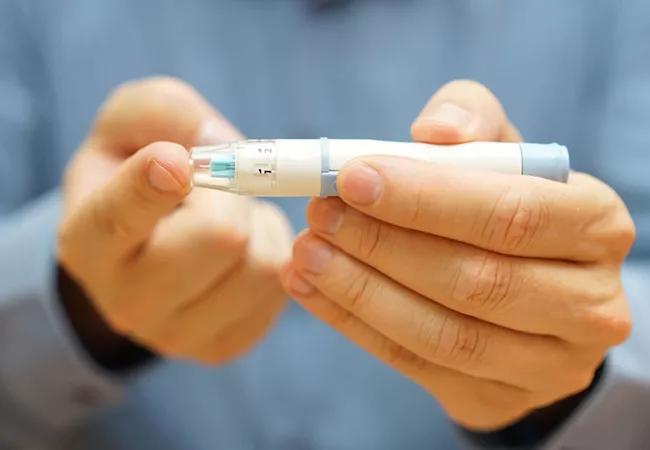Exploring the potential clinical outcomes of two treatment approaches

By Bartolome Burguera, MD, PhD
Advertisement
Cleveland Clinic is a non-profit academic medical center. Advertising on our site helps support our mission. We do not endorse non-Cleveland Clinic products or services. Policy
Generally, weight gain is the consequence of an increase in calorie intake or a decrease in calorie utilization. In patients with type 2 diabetes (T2D), weight gain can result from a number of specific factors, including:
There are two approaches to treating patients with obesity and pre-diabetes or T2D: glucocentric or adipocentric. In glucocentric treatment, diabetes is considered the primary problem and obesity a complication. The therapeutic target is HbA1c. We know that over time, with a glucocentric approach, glucose control gets worse and more medications will be needed. Additionally, many first-line diabetes therapies, such as sulphonylurea or thiazolidinediones, usually cause weight gain.
Advertisement
In adipocentric treatment, obesity is the chronic disease, and pre-diabetes or T2D are comorbidities. The therapeutic target is weight loss reduction; HbA1c improves in parallel. Medication for diabetes may still be necessary; however, care is taken to try to avoid diabetes medications known to cause weight gain, and medication is only one aspect of an intensive lifestyle intervention. Weight loss would also improve blood pressure, cholesterol among other metabolic factors.
A 48-year-old patient presents with a primary complaint of pre-diabetes. The patient has an 18-year history of obesity, and cites portion sizes, medications, eating too much fat and sugar, emotional eating and lack of physical activity as major contributing factors to her weight gain. She was diagnosed with pre-diabetes last year, and lifestyle intervention and metformin 500 mg bid were prescribed. The patient has since discontinued the metformin, claiming she was unable to tolerate it due to its gastrointestinal side effects. Over the previous six months, her glucose control has deteriorated; her HbA1c level has increased from 5.8% to 6.1%.
Although the patient’s BMI is 41.97 kg/m2, it is her pre-diabetes—not her BMI—which prompted her to make this appointment. Additionally, BMI was not listed on the patient’s problem list by her referring provider. She does have several other comorbidities, including a diagnosis of bipolar disease, for which she takes several medications that are known to cause weight gain due to uncontrolled appetite. These include lurasidone HCL, lithium, gabapentin and trazadone.
Advertisement
The patient reports feeling hungry all the time, though she has recently lost about 10 lbs. Her physical activity level is limited. She reports fatigue, pain in both knees and her back, nocturia and depression, as well as a prior diagnosis of stiff-man syndrome. With the exception of BMI, the patient has a normal physical exam.
There are two possible care paths here: one that focuses on the patient’s HbA1c through additional diabetes medication, and another that focuses on weight loss through lifestyle intervention with or without the addition of weight loss medications.
If we were to treat according to the glucocentric model, we might decide that the patient is non-compliant since she stopped the metformin. We would consider medications that might be easier on her stomach, such as glimepiride (a sulphonylurea) or a thiazolidinedione. We should also recommend that she follow up with psychiatry to address her mental health issues and with neurology for stiff-man syndrome. We add glimepiride, and our first HbA1c goal is a decrease from 6.1% to 5.9%.
Without addressing some of the other factors that may be contributing to her decreasing glucose control, the patient will likely continue to eat poorly and will not exercise. She may have increased joint pain, may develop obstructive sleep apnea and her BMI may continue to increase. Our glucose control goals are not likely to be met or sustained, and the patient may become even more frustrated.
If we were to treat according to an adipocentric model, this patient’s obesity is considered the chronic disease and her pre-diabetes as a comorbidity. We would prescribe personalized weight loss and exercise programs and consider prescribing appetite-suppressants to control the effects of her medications. If the patient fully develops T2D, we might prescribe a sodium/glucose cotransporter 2 (SGLT2) or a glucagon-like peptide 1 (GLP-1) analogue to address the A1c and glucose levels. We would recommend that she monitor her blood glucose daily, and follow up with ophthalmology once per year. We will also check the patient’s HbA1c levels in three months.
Advertisement
We would still refer to psychology and neurology, but in this scenario, we consult with the psychiatrist before the appointment to determine if there are other bipolar medications that might be effective without the appetite-inducing side effects. With close psychiatric follow-up, the patient may wean from trazodone and lurasidone HCl, while continuing the lithium and adding bupropion. We would also refer the patient to nutrition and exercise physiology, and recommend that the patient start walking for 60 minutes each day.
With this regimen, which treats obesity as the chronic disease, the patient should experience weight loss (or at least stop gaining weight) and improved glucose control, lipid profile, blood pressure and sense of well-being, among other important benefits for her health. In contrast, it seems counterproductive to treat the blood sugar with medications that may cause weight gain and perpetuate her T2D. Weight loss is the best therapeutic approach to get her diabetes into remission long term.
Advertisement
Advertisement

A reconcilable divorce

A review of the latest evidence about purported side effects

High-volume surgery center can make a difference

Advancements in equipment and technology drive the use of HCL therapy for pregnant women with T1D

Patients spent less time in the hospital and no tumors were missed

A new study shows that an AI-enabled bundled system of sensors and coaching reduced A1C with fewer medications

Association revises criteria for the diagnosis and resolution of severe conditions

Insulin use at time of hospital discharge can offer clues for the future